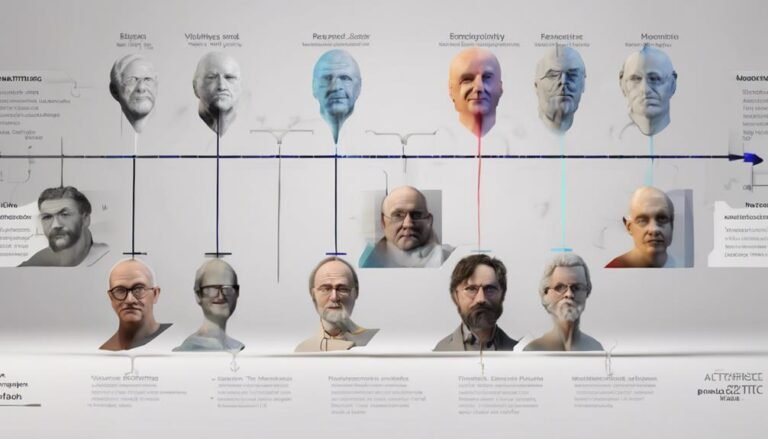Introduction to Evolutionary Theories
Imagine evolution as a grand puzzle, each piece representing a different aspect of life's intricate tapestry. Just as you start connecting a few fragments, your curiosity piques about the bigger picture. How do these pieces fit together? What stories do they reveal about the origins of species and the diversity of life on Earth? The journey through evolutionary theories is like unraveling the secrets of this ancient puzzle, offering insights into the fascinating mechanisms that drive the ever-evolving world around you.
Key Takeaways
- Lamarckian inheritance and Darwin's natural selection revolutionized biology.
- Genetic variation drives adaptation and diversity within populations.
- Fossil records reveal transitional forms and evolutionary history.
- Speciation occurs through geographic isolation and reproductive barriers.
- Evo-Devo studies genetic mechanisms in organism development and evolutionary novelties.
The Origins of Evolutionary Theories
Evolutionary theories, tracing back to ancient civilizations and gaining momentum in the 19th century, have origins that penetrate deep into the history of scientific inquiry. Lamarckian inheritance, proposed by Jean-Baptiste Lamarck in the early 19th century, suggested that organisms could pass on acquired traits to their offspring. This theory laid some groundwork for later evolutionary thought.
One pivotal event that shaped evolutionary theories was Charles Darwin's voyage on the HMS Beagle from 1831 to 1836. During this expedition, Darwin observed a wide variety of species, including finches on the Galapagos Islands. These observations led him to develop his theory of natural selection, which he later presented in his groundbreaking work, 'On the Origin of Species.'
Darwin's voyage and subsequent work laid the foundation for modern evolutionary biology. His theory of natural selection, combined with later discoveries in genetics and molecular biology, has provided a comprehensive framework for understanding the diversity and adaptation of life on Earth.
Charles Darwin and Natural Selection
Charles Darwin revolutionized the field of biology with his groundbreaking theory of natural selection, which provided a compelling explanation for the mechanism driving evolutionary change. Darwin's influence on the understanding of evolution can't be overstated.
His concept of natural selection, often summarized as 'survival of the fittest,' proposed that organisms best adapted to their environment are more likely to survive and reproduce, passing on their advantageous traits to future generations. This process leads to the gradual change and adaptation of species over time.
Darwin's theory of natural selection was supported by extensive evidence gathered during his voyages, particularly the observations he made on the Galapagos Islands. Through meticulous documentation of various species and their adaptations to different environments, Darwin provided a solid foundation for his revolutionary ideas.
The concept of survival of the fittest continues to be a fundamental principle in evolutionary biology, shaping our understanding of how species evolve and thrive in diverse ecosystems.
Genetic Variation and Adaptation
Following the foundational concepts of natural selection proposed by Charles Darwin, the discussion now shifts to the role of genetic variation and adaptation in driving evolutionary change.
Genetic variation, influenced by processes like gene flow, is vital in population genetics as it introduces diversity within populations. This diversity is essential for species to adapt to changing environmental pressures.
Environmental pressures, such as competition for resources or changes in climate, act as selection forces that shape the evolution of populations. Individuals with advantageous traits, resulting from genetic variation, are more likely to survive and reproduce, passing on these beneficial traits to future generations. This process, known as adaptation, is the cornerstone of evolution.
Survival strategies, which include behaviors and physical traits that enhance an organism's chances of survival and reproduction, are directly linked to genetic variation.
Through the interplay of gene flow, population genetics, and environmental pressures, species evolve over time, continually adapting to safeguard their survival in changing environments.
Fossil Records and Transitional Forms
Genetic variation and adaptation play an essential role in driving evolutionary change, influencing the survival strategies of organisms in response to environmental pressures.
Fossil records provide critical insights into the history of life on Earth, offering paleontological evidence of intermediate species that bridge the evolutionary gaps between different groups of organisms.
One of the most intriguing aspects of the fossil record is the search for missing links, which are intermediary forms that exhibit characteristics of both ancestral and descendant groups.
These intermediate species help scientists trace the evolutionary history of various organisms and understand how certain traits evolved over time.
For example, the discovery of Archaeopteryx, a fossil with features of both dinosaurs and birds, provided significant evidence for the evolutionary link between these two groups.
Speciation and Diversification
The process of speciation and diversification is a fundamental aspect of evolutionary theory, shedding light on how new species arise and adapt to various ecological niches over time.
Speciation can occur through various mechanisms, with geographic isolation playing an essential role. When populations are separated by geographical barriers like mountains or bodies of water, they can evolve independently due to limited gene flow, leading to genetic drift and eventually the development of reproductive barriers.
These reproductive barriers, such as differences in mating behaviors or physical incompatibilities, prevent individuals from interbreeding even if they come into contact again.
As populations adapt to their specific ecological niches, natural selection further drives the divergence between them, potentially resulting in the formation of distinct species.
The interplay between geographic isolation, genetic drift, ecological niche specialization, and reproductive barriers underscores the complexity of speciation and diversification in evolutionary processes.
Evolutionary Developmental Biology (Evo-Devo)
Evolutionary Developmental Biology (Evo-Devo) studies the genetic and molecular mechanisms that control the development of organisms and how these processes have evolved over time. Through the lens of Evo-Devo, scientists examine how gene regulation influences the morphological evolution of organisms.
Gene regulation plays a fundamental role in determining when and where genes are turned on or off during development, leading to the formation of distinct body structures and functions. By understanding these regulatory processes, researchers can unravel the genetic basis of evolutionary changes in morphology.
The field of Evo-Devo has provided valuable insights into the developmental origins of evolutionary novelties, such as the evolution of new body shapes or the emergence of unique features in different species. By comparing the developmental pathways of diverse organisms, scientists can uncover shared genetic mechanisms that underlie morphological evolution.
This comparative approach highlights the conserved principles of developmental biology that drive evolutionary change across different species.
Contemporary Debates in Evolutionary Theory
Engaging in critical discourse, scholars and researchers actively debate the nuances and implications of contemporary theories within the domain of evolution. One of the key debates revolves around the pace of evolutionary change. While some scientists advocate for gradualism, suggesting that evolution occurs steadily over time, others support punctuated equilibrium, proposing that species experience long periods of stability interrupted by sudden bursts of change.
Another hotly contested topic is the role of genetic mechanisms in evolution. Genetic drift, the random fluctuation of allele frequencies in a population, is a subject of debate regarding its significance in driving evolutionary change. On the other hand, gene flow, the transfer of genes between populations, raises questions about how it influences genetic diversity and adaptation.
These debates are essential for advancing our understanding of evolution and shaping future research directions. By critically evaluating these contemporary theories, scholars contribute to the ongoing development of evolutionary theory.
Conclusion
To sum up, evolutionary theories are like a constantly evolving mosaic, with each piece adding depth and complexity to our understanding of life's diversity.
From Darwin's groundbreaking concept of natural selection to the intricate patterns of genetic variation and adaptation, the tapestry of evolution continues to unfold before our eyes.
Fossil records and speciation provide snapshots of the past, while evolutionary developmental biology offers a glimpse into the future.
The ongoing debates in evolutionary theory shape the ever-changing landscape of scientific discovery.







